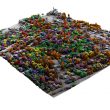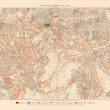The Green City Index shows the access to green spaces in American cities
In recent years more and more focus has been paid to green spaces in cities and is becoming a thing that is more often considered when doing urban planning.
There are multiple reasons why this is important, one of the key areas being that access to green spaces is considered a key component to quality of life. Multiple studies have demonstrated how plentiful access to green spaces can help alleviate and prevent the development of mental illnesses such as anxiety and depression. This is underlined by the fact that the World Health Organization (WHO) has developed specific guidelines for what is considered appropriate access to green spaces for urban residents. Currently the guidelines is that residents should have access to at least 0.5 hectares of green within 300 meters of where they live and provides a specific metric for assessing a city’s level of “greenness” together with other metrics such as overall green area percentage.
The tricky part, however, is how to evaluate this with comprehensive data across cities. Green City Index data provides a unique insight into this with the analysis of green spaces in the 500 biggest (most populous) cities in the US. The tool which is made available to the public allows you to look up the desired city and get insights into data such as the overall green area percentage, the number of residents living within 1,000 feet of 0.5 hectares of green (i.e. following the WHO guideline as mentioned above) and the number of square feet of green per resident.
The gallery above features selected data from the Green City Index showing the top 10 cities in the U.S. as ranked based on the WHO guideline, i.e., the percentage of the population that lives within 1,000 feet from at least 0.5 hectares of green. The ranking is based on satellite data analyzed in 2020.
Out of the 500 cities analyzed, almost 400 cities show “green improvement” as opposed to 2010, when the number hit just about 350, so we’re definitely seeing a positive development of greening the urban area. Still, with climate change and everything going wrong with the environment, hope remains that the positive trend will continue growing.
Nikolaj Astrup Madsen is a founder of Interiorbeat, a company that aims to create more transparency in the furniture industry and push the industry to create more environmentally friendly products. Interiorbeat has created free tools as The Green City Index and The Furniture Footprint Calculator. He has a deep interest in urban planning and how people live.




















